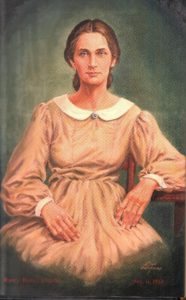 Nancy Hanks Lincoln died October 5, 1818 of “the milk sick.” Or did she? While Abraham Lincoln biographers generally attribute her death to milk sickness, a possibility exists that it might have actually been something else. The story goes like this:
Nancy Hanks Lincoln died October 5, 1818 of “the milk sick.” Or did she? While Abraham Lincoln biographers generally attribute her death to milk sickness, a possibility exists that it might have actually been something else. The story goes like this:
Early in October, Thomas and Elizabeth Sparrow, relatives of Nancy who had joined them in Indiana the previous year, died of the milk sickness. Within two weeks, Nancy began showing symptoms and after a week of agony, died. While the Lincolns and others knew vaguely it was associated with milk, no one had yet connected the disease with the ultimate source. Some had noticed the seasonality of the disease and that it seemed to occur more often in years in which natural forage vegetation was in short supply. Less than normal rain in 1818 had resulted in dusty conditions and low crop yields. As a result, the Lincolns’ livestock instinctively foraged for food wherever they could find it, often into the underbrush of the neighboring forest. What they found was a weedy plant now known to be white snakeroot (current scientific name Ageratina altissima).
While early observations suggesting plants as a source occurred before Nancy’s death, it was not until 1834 that a physician and scientist named Anna Pierce Hobbs Bixby learned the connection to white snakeroot and led a campaign to eradicate the weed from her Rock Creek, Illinois community. Ohio farmer William J. Vermilya independently implicated white snakeroot in 1837. Given the lack of scientific infrastructure, these early discoveries were insufficient to settle the issue and as late as 1841 the Kentucky legislature was offering $2,000 to anyone “who shall, within five years after the passage of this act” succeed in discovering “the true cause of the disease, now known to be caused by the poisonous effects of the wild, flowering white snakeroot transmitted by the milk, butter, and flesh of cattle consuming the plant.”
That “true cause” was a natural toxin called tremetone that remains active even after the plant was dried for hay. Sometimes farmers noticed listlessness, trembling, and peculiar odors found in the breath of cattle, sheep, and horses. The tremetone easily passes into the milk, which was how most humans were exposed to the toxin. Milk sickness was not a pleasant disease. One of the symptoms is a scent similar to acetone (similar to today’s nail polish remover). Persistent vomiting, abdominal pains, muscle stiffness, and eventually tremors, respiratory distress, and agonizing pain were obvious to the Lincoln family. Not seen was the intense inflammation of Nancy’s gastrointestinal tract, enlarged liver and kidneys, and swelling of her heart. Milk sickness was a painful death.
The definitive conclusion that milk sickness was caused by tremetone was not determined until the early twentieth century. In 1818, all the preadolescent Abe could do was helplessly watch his mother die. Death from the lack of scientific knowledge was one reason Lincoln later supported the greater use of science in agriculture—and the broad dissemination of information to farms of all sizes throughout the nation.
But wait. Tremetone? Virtually everyone that mentions milk sickness says the toxic is called tremetol, not tremetone. For those who are into organic chemistry, the “-ol” means it is the alcohol version of the chemical; the “-one” means it is the ketone version. [Since this isn’t a chemistry lesson, you can look up the difference.] Tremetone is found in tremetol, which is actually a toxin mixture from the aforementioned white snakeroot plant. While most sources say the tremetol is the toxic component, biomedical researcher and Lincoln historian Edward Steers, Jr. argues that tremetone is the actual toxic chemical. Like Steers, I’m also both a scientist and Lincoln historian, so I think I’ll go along with him on this one.
But wait, there’s more.
Steers also suggests that Nancy may not have died of milk sickness at all. When you think about it, the circumstances seem suspect, not the least of which is the fact that no one else in the Lincoln family died despite all of them drinking the same milk and eating the same food. Steers suggests that Nancy may possibly died of brucellosis, a bacterial disease associated with unpasteurized milk or undercooked meat, especially from goats but also from cows and pigs. Symptoms are similar to milk sickness, including fever, sweating, vomiting, weight loss, and muscle pain. Because it is contagious, Nancy may have gotten it when she was nursing the Sparrow family.
So was it milk sickness, brucellosis, or something completely different? In truth, we don’t really know. The series of symptoms and deaths were attributed to milk sickness at the time, but as we’ve seen, they didn’t really understand what was causing the disease, just that it had some vague connection to milk. Or so they thought. Since it’s impossible to accurately diagnose from the limited anecdotal hearsay available from family and friends, biographers stick to the generally accepted story that Lincoln’s mother died from milk sickness. But maybe she didn’t. This is an important reminder that historians need to be careful when they simply report old sources without fully researching the details. And perhaps, that more scientists need to be historians.
[Adapted from my forthcoming book]
David J. Kent is an avid traveler, scientist, and Abraham Lincoln historian. He is the author of Lincoln: The Man Who Saved America, Tesla: The Wizard of Electricity and Edison: The Inventor of the Modern World as well as two specialty e-books: Nikola Tesla: Renewable Energy Ahead of Its Time and Abraham Lincoln and Nikola Tesla: Connected by Fate.
Check out my Goodreads author page. While you’re at it, “Like” my Facebook author page for more updates!










